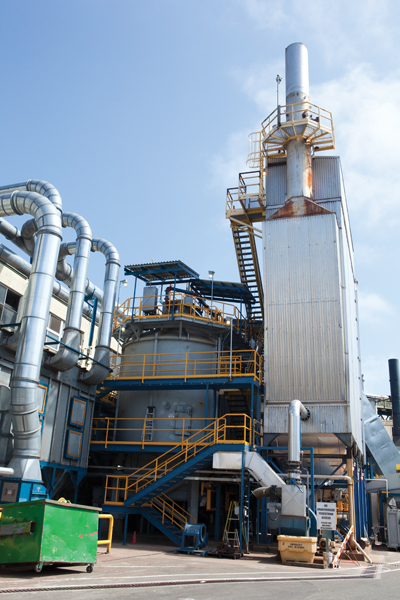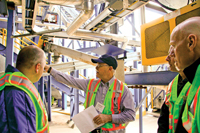
All Fired Up With Biomass
December 1, 2010
By Stefanie Wallace
Kruger Products is showing off a new system that’s allowing it to replace natural gas with biomass energy.
Kruger Products is showing off a new system that’s allowing it to replace natural gas with biomass energy. In late September 2010, approximately 50 representatives from the forest products and pulp and paper industries attended a demonstration of the new technology at Kruger Products’ paper mill in New Westminster, British Columbia. The demo, hosted by FPInnovations, showed participants a direct-fired biomass gasification system that’s producing 40,000 pounds/hour of process steam for the mill.
 |
|
| The Nexterra system at the Kruger Products tissue mill is the first commercial installation of this direct-fired biomass gasification system. Photos: Nexterra |
In this system, synthetic gas, or syngas, is used directly in the boiler in place of natural gas. Adding heat to woody biomass releases the energy into a gaseous form called syngas. The syngas is burned in a pre-ignition chamber and direct-fired into the boiler. Nexterra installed the gasification system, which was first fired up in December 2009, according to Frank Van Biesen, vice-president of technology for Kruger Products and sponsor of the project. “We started it roughly a year prior to that. We had a timeline that said we would be starting up in the first week of December of 2009 and we never missed a beat there,” he says.
Once installed, the gasification system went through the normal commissioning process. “There’s been some optimization and commissioning to make it a better performing system, but for the most part, it turned on and met the output capacity,” says Darcy Quinn, manager of marketing and business development for Nexterra. “One of the major advantages of doing this is the significantly lower emissions, which suits the environment,” says Quinn.
Van Biesen says that Kruger Products chose Nexterra for the project based on its technology. The proven emission reductions were helpful in getting the project underway, he says, noting, “A permit for burning things besides natural gas isn’t easy to get, especially in an urban centre.” According to Van Biesen, the emissions will be recorded and reported by Kruger Products as required on an ongoing basis.
Kruger, Nexterra, and FPInnovations formed a consortium to build the system, which is the first commercial demonstration of Nexterra’s direct-fired gasification solution. “FPInnovations’ interest in it was to have the ability to demonstrate and showcase it to the rest of the industry, to see whether or not it could provide similar benefits to other parts of the forest products or paper industry,” says Van Biesen. The multi-million dollar project received funding from Natural Resources Canada, the British Columbia Innovative Clean Energy Fund, and Western Economic Diversification Canada. “There was a bit of a consortium of financial support there, which helped. But at the end of the day it was still largely our investment,” he notes.
 |
|
| Rick Scammell, utilities manager for Kruger Products, explains the biomass gasification system installed at Kruger to tour participants. |
Incorporating the gasification system was part of a long-term goal to reduce the company’s environmental footprint. With this project, the company is targeting the reduction of fossil energy consumption and greenhouse gas emissions. Locally sourced wood waste and residues will be replacing about 445,000 GJ/year of natural gas, reducing greenhouse gas emissions by more than 22,000 tonnes/year.
“It’s part of a larger strategy called Sustainability 2015,” says Van Biesen. “We’re looking to improve on a number of fronts, including energy usage, solid waste management, and water consumption. This particular case is a fossil fuel reduction project. We just so happened to have Nexterra, a technology development company that’s based in British Columbia, who has something that is interesting from a biomass standpoint.
It just seemed to be a perfect fit for our New Westminster operation, where we use quite a bit of steam for drying in the paper-making process.” He adds that Kruger Products has already reduced greenhouse gas emissions at the mill by nearly 40%.
The application of the direct-fired boiler technology has already received a Canadian Institute of Technology Award in British Columbia and a British Columbia Technology Industry Association award, says Van Biesen. The project is also short listed for a Green Energy and Biofuels Award from Pulp and Paper International, and a Platts Global Energy Award for green energy initiative of the year, he adds.
Looking ahead, Van Biesen suspects that Kruger may be adding similar biomass projects in the future. “It depends on the site,” he says. “The Westminster system is not a cookie-cutter thing we can put
everywhere.”
“The key thing about biomass projects is you need the fuel. Wherever there is an opportunity to secure that type of material within a reasonable footprint—we don’t want to be trucking it from miles away—we’ll be looking at it for sure,” Van Biesen says. “In the case of the New Westminster plant, there’s a possibility to expand the system we put in by another 50%, which we’re looking at today.”
Print this page